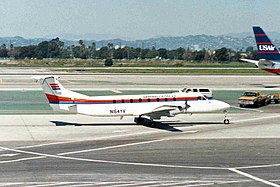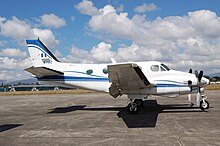United Express flight 5925
| United Express flight 5925 | |
|---|---|
| Accident summary | |
| Accident type | Collision on the ground |
| place |
Quincy Municipal Airport , Quincy , Illinois , United States |
| date | November 19, 1996 |
| Fatalities | 14th |
| Injured | 0 |
| 1. Aircraft | |
| Aircraft type |
|
| operator |
|
| Mark |
|
| Departure airport |
Chicago O'Hare International Airport , Chicago , Illinois , United States |
| Stopover |
Southeast Iowa Regional Airport , Burlington , Iowa , United States |
| Destination airport |
Quincy Municipal Airport , Quincy , Illinois , United States |
| Passengers | 10 |
| crew | 2 |
| Survivors | 0 |
| 2. Aircraft | |
| Aircraft type |
|
| operator | Private |
| Mark |
|
| Passengers | 0 |
| crew | 2 |
| Survivors | 0 |
| Lists of aviation accidents | |
The United Express flight 5925 (Flight number: ZK5925 ) was a regional flight from Chicago O'Hare International Airport in Chicago , Illinois to the Regional Airport Quincy Municipal Airport in Quincy , Illinois. On November 19, 1996 the flight was carried out with a Beechcraft 1900C of the Great Lakes Airlines , which collided with a private Beechcraft 65-A90 King Air while landing in Quincy . The 12 occupants of the Beechcraft 1900C, who initially survived the collision, died in the fire that subsequently broke out because a passenger door of the machine could not be opened from the outside or the inside and the passengers were not aware that the aircraft had an additional emergency exit.
Aircraft and crews
First airplane
The passenger plane involved in the accident was a Beechcraft 1900C , which was delivered on December 28, 1989 to the sole operator Great Lakes Airlines . Initially the machine was registered with the aircraft registration N819GL , from August 1992 it was operated with the new registration N87GL . The machines were controlled by a 30-year-old captain Kate Gathje and the 24-year-old first officer Darren McCombs.
Second plane
The second machine affected was a private Beechcraft 65-A90 King Air . The machine was registered with the aircraft registration number N1127D . It was registered for the first time in August 1967, had the serial number LJ-223 and was financed by a private operator through Centurion Investment, which was the third owner of the machine. The machine was piloted by 34-year-old Laura Brooks Winkleman, who had a professional pilot's license and wanted to acquire her type rating for King Air. She was in the machine with her flight instructor, 63-year-old Neil Reinwald.
the accident
The Beechcraft 1900C took off from Chicago at 3:25 p.m. local time. Apart from the two pilots, there were no other crew members on board. Instead of being presented by flight attendants, as is usual on passenger flights, the safety instructions were recorded in the form of a video. For the flight to Quincy, 10 passengers were seated in the Beechcraft 1900C. The flight to the scheduled stopover at the Southeast Iowa Regional Airport in Burlington , Iowa went without incident.
While the aircraft was approaching Quincy Airport on runway 13, two small aircraft, a Beechcraft King Air and a Piper Cherokee , had rolled to the crossing runway 4. Since the small airport was not monitored by a control tower , the sequence of departures and approaches was coordinated between the pilots by radio. The captain of the United Express plane inquired over the radio whether the King Air crew was planning to wait for their landing or would like to take off beforehand. When she got no answer, she repeated her question. When repeating the request over the radio, the pilot of the Piper Cherokee assumed that it was addressed to him. He said he was waiting behind King Air. The last words of the radio message, "King Air", were no longer received by the captain of the landing machine because at that moment a warning tone from the aircraft's ground proximity warning system sounded. The captain wrongly assigned the radio message to the crew of King Air. Assuming that both machines were waiting to land, she lowered her machine onto the runway. At that moment the King Air rolled off and collided with the Beechcraft 1900C at the intersection of the two runways.
The two occupants of King Air were killed in the collision. The occupants of the United Express machine initially all survived the collision. However, a fire had broken out on the machine. First responders rushed to the Beechcraft 1900C and tried to open the main door, which they failed despite trying for minutes. The occupants of the machine couldn't open the door from the inside either.
Cause of accident
When determining the cause of the accident, the aircraft accident investigators first checked the door that could not be opened. They found that the collision had loosened the cable that opened the door latches. Due to the lack of tension on the rope, the door mechanism no longer worked.
Most of the dead were found around the blocked main door. The Beechcraft 1900C had an emergency exit in the middle on the left side next to the main door. It was found that after the first officer was unable to open the blocked main door, he tried to get to the rear door. Based on the location of the first officer's corpse, investigators concluded that the thick smoke left the officer unable to act before he could reach the door.
The investigators attributed the fact that the rear door was not used to the fact that the passengers had not carefully followed the video with the safety instructions that was recorded before departure.
When investigating the reasons for the collision between the two machines, the investigators found that the landing machine was always clearly visible from the cockpit of the King Air. The crew of King Air, above all the flight instructor Neil Reinwald, had obviously neglected to watch out for approaching aircraft.
Individual evidence
- ↑ a b c d e f g Final report of the National Transportation Safety Board (English), accessed on March 19, 2019.
- ↑ a b c d e f g h i Accident report N87GL Aviation Safety Network (English), accessed on March 19, 2019.
- ↑ Approval Beechcraft 1900C N87GL Federal Aviation Administration (English), accessed on March 19, 2019.
- ↑ Approval Beechcraft 65-A90 King Air N1127D Federal Aviation Administration (English), accessed on March 19, 2019.
- ↑ Accident report Beechcraft King Air A90, N1127D Aviation Safety Network (English), accessed on March 19, 2019.
Coordinates: 39 ° 56 '27.4 " N , 91 ° 11' 39.3" W.


